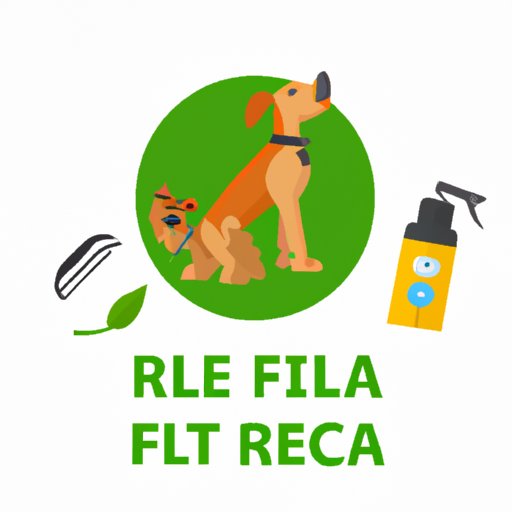
I. Introduction
As a pet owner, you know that fleas are a common problem, especially in warmer months. Not only are they pesky and irritating for your dog, but a flea infestation can quickly spread to your home and other pets. This article will provide various remedies and solutions to get rid of fleas on your dog.
II. Natural Remedies for Flea Control
Natural remedies can be effective in controlling fleas on your dog without exposing them to harmful chemicals. Here are some of the most effective natural ways to control fleas:
Essential oils
Certain essential oils have flea-repellent properties, including lavender, peppermint, and cedarwood. However, it’s important to properly dilute and apply them to ensure they are safe for your pet.
We recommend diluting the essential oil in a carrier oil, such as coconut or almond oil. Use only a few drops of the essential oil and mix it well in the carrier oil. Rub the oil mixture on your dog’s neck and back, avoiding their eyes and mouth.
Apple Cider Vinegar
Apple cider vinegar is a natural flea repellent and can also help soothe itchy skin. Mix equal parts of apple cider vinegar and water, then pour the solution into a spray bottle. Spray the solution onto your dog’s coat, avoiding their eyes and mouth.
Diatomaceous Earth
Diatomaceous earth is a fine powder made from the fossilized remains of tiny aquatic organisms. It works by dehydrating fleas and other insects, ultimately killing them. Dust a small amount of diatomaceous earth onto your dog’s coat, focusing on the neck, back, and tail. Be sure to use food-grade diatomaceous earth as it’s safe for your pet to ingest.
III. Flea Shampoos and Soaps
Flea shampoos and soaps are an effective and easy way to get rid of fleas on your dog. Look for a shampoo or soap that contains natural ingredients such as eucalyptus or lemongrass.
When washing your dog, lather the shampoo or soap onto their coat, focusing on the neck, back, and tail. Let the shampoo or soap sit for a few minutes before rinsing thoroughly. Use flea shampoo no more than once a month, as it can be harsh on your dog’s skin.
IV. Sprays for Flea Control
Flea control sprays are another option for treating fleas on your dog. There are both natural and chemical-based flea sprays available, so be sure to read the ingredients carefully.
When using a flea spray, spray the solution onto your dog’s coat, avoiding their eyes and mouth. Massage the solution into their coat and let it dry completely before brushing them. For best results, use flea spray every two weeks.
V. Flea Collars
Flea collars are a long-lasting flea control option that can last up to eight months. Flea collars work by releasing a chemical that kills fleas and their eggs.
When using a flea collar, make sure it fits snugly around your dog’s neck, with room for two fingers to fit comfortably underneath. Be sure to read the instructions carefully on how to properly use the collar.
VI. Vacuuming and Cleaning
Keeping your home and dog’s belongings clean can go a long way in controlling fleas. Here are some tips to keep your home flea-free:
Vacuuming your home
Vacuum your home at least once a week, focusing on areas where your dog spends time. Be sure to vacuum under furniture and along baseboards, as fleas and their eggs can hide in these areas.
Washing your dog’s bedding and toys
Wash your dog’s bedding and toys regularly in hot water. This will kill any fleas or eggs that may be hiding on them.
Keeping your yard free of debris
Keeping your yard free of debris, such as fallen leaves and tall grass, can help discourage fleas from living in your yard.
VII. Preventing Future Flea Infestations
Preventing future flea infestations is critical to keeping your dog and home flea-free. Here are some preventive measures:
Flea prevention products
Speak with your veterinarian about flea prevention products, such as chewable tablets that prevent fleas from reproducing. These products can be highly effective in preventing a flea infestation.
Regular grooming
Regular grooming, such as brushing and bathing your dog, can help you spot fleas early on and prevent them from multiplying. Additionally, grooming helps distribute natural oils throughout your dog’s coat, which can help repel fleas.
Treating your home and yard for fleas
If you’ve had a flea infestation, it’s important to treat your home and yard to eliminate any remaining fleas and their eggs. Speak with your veterinarian or pest control professional about the best treatment options.
VIII. Conclusion
Controlling fleas on your dog requires a multi-pronged approach, from natural remedies to flea shampoos, sprays, and collars. Regular cleaning and preventive measures are also key to avoiding future flea infestations. By following the tips outlined in this article, you can help keep your dog and home flea-free.
Remember, if your dog continues to have fleas or shows signs of flea allergy, speak with your veterinarian for further advice and treatment options.




